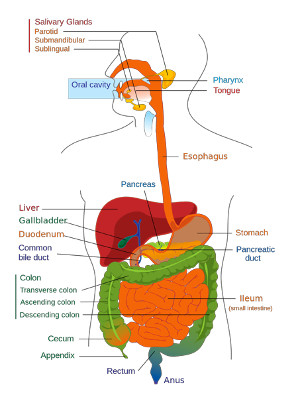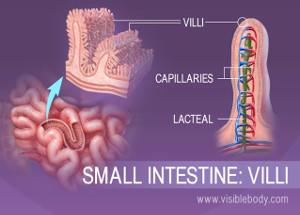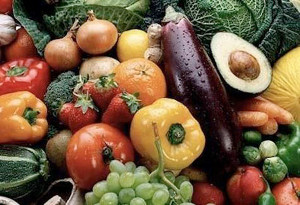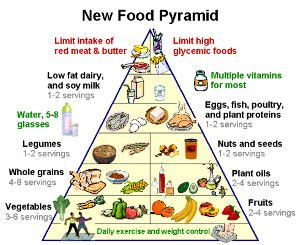 The digestive system is made up of the gastrointestinal (GI) tract, the liver with gall bladder and the bile ducts that connect them, and pancreas. The GI tract is a series of hollow organs consisting of oesophagus (food pipe), stomach, small intestine and colon (large intestine) that includes the rectum, joined in a long, twisting tube from the mouth to the anus. Food enters the mouth and passes to the anus through the hollow organs of the GI tract. The liver and pancreas are the solid organs of the digestive system. The digestive system helps the body digest the food.
The digestive system is made up of the gastrointestinal (GI) tract, the liver with gall bladder and the bile ducts that connect them, and pancreas. The GI tract is a series of hollow organs consisting of oesophagus (food pipe), stomach, small intestine and colon (large intestine) that includes the rectum, joined in a long, twisting tube from the mouth to the anus. Food enters the mouth and passes to the anus through the hollow organs of the GI tract. The liver and pancreas are the solid organs of the digestive system. The digestive system helps the body digest the food.
Bacteria in the GI tract, also called gut flora or microbiome, help with digestion. Parts of the nervous and circulatory systems also play roles in the digestive process. Together, a combination of nerves, hormones, bacteria, blood, and the organs of the digestive system completes the complex task of digesting the foods and liquids a person consumes each day.
Digestion works by moving food through the GI tract. Digestion begins in the mouth with chewing and ends in the small intestine. As food passes through the GI tract, it mixes with digestive juices (comprising bile from liver and pancreatic juice with enzymes), causing large molecules of food to break down into smaller molecules. The body then absorbs these micro molecules through the walls of the small intestine into the bloodstream, which delivers them to the rest of the body. Waste products of digestion pass through the large intestine and anus out of the body as a solid matter called faeces.
How do the digestive juices in the GI tract break down food?
Digestive juices contain enzymes that are substances which speed up chemical reactions in the body to break food down into different nutrients.
Salivary glands : Saliva produced by the salivary glands lubricates food so it moves more easily through the esophagus into the stomach. Saliva also contains an enzyme that breaks down the starches from food.
Stomach : The glands in the stomach lining produce hydrochloric acid and an enzyme that digests protein.
Pancreas : The pancreatic juice contains several enzymes that break down carbohydrates, fats, and proteins in food. The pancreas delivers digestive juice to the small intestine through small tubes called pancreatic ducts (PD).
Liver : The liver is an amazing organ whose functions are many. It produces a digestive juice called bile. The gallbladder stores bile between meals. When a person eats, the gallbladder squeezes bile through the bile ducts, which connect the gallbladder and liver to the small intestine. The bile mixes with the fat in food. The bile acids dissolve fat into the watery contents, much like how soap removes oil from an oily hand to let the intestinal and pancreatic enzymes digest the fat molecules.
Small intestine : Digestive juice produced by the small intestine combines with pancreatic juice and bile to complete digestion. The body completes the breakdown of proteins, and the final breakdown of starches produces glucose molecules that absorb into the blood. Many microbes (bacteria like Bacteroides, Lactobacillus acidophilus, Escherichia coli, and Klebsiella) in the large intestine help in the digestion process
Large intestine : After passing through the small intestine, food passes into the large intestine. In the large intestine, some of the water and electrolytes (chemicals like sodium) are removed from the food. The first part of the large intestine is called the cecum (the appendix is connected to the cecum). Food then travels further in the ascending colon, transverse colon, the descending colon, and then through the sigmoid colon.
The end of the process : Solid waste is then stored in the rectum until it is excreted via the anus.

- Digestion breaks down food into nutrients, which the body uses for energy, growth, and cell repair.
- Digestion works by moving food through the gastrointestinal (GI) tract.
- Digestion begins in the mouth with chewing and ends in the small intestine.
- As food passes through the GI tract, it mixes with digestive juices, causing large molecules of food to break down into smaller molecules. The body then absorbs these smaller molecules through the walls of the small intestine into the bloodstream, which delivers them to the rest of the body.
- The small intestine has villi to increase the area of absorption of food.
- Waste products of digestion pass through the large intestine and out of the body as a solid matter called stool.
- Digestive juices contain enzymes that break food down into different nutrients.
- The small intestine absorbs most digested food molecules, as well as water and minerals, and passes them on to other parts of the body through blood stream for storage or further chemical change. Hormone and nerve regulators control the digestive process.
The Ten Commandments for Better Health and Long Life
Observe Basic Hygiene
Wash your hands with soap before meals. Rinse your mouth thoroughly before and after eating food. Drink clean drinking water. Always carry with you potable water.
Drink Plenty of Water
Water aids your digestive health by helping to cleanse the entire system. Aim to drink eight glasses of water a day, and avoid the sugary drinks. Added sugars can make digestion problems worse.
Eat More Fiber
Fiber is the bulk in plant foods that can’t be digested by humans. Fiber adds bulk to stools. Getting enough fiber helps prevent digestion problems by regulating the system. Fiber is naturally available in fruits, vegetables, beans, legumes, whole grains. It prevents constipation.
Eat Small Frequent Meals
Avoid eating a big meal. Smaller more frequent meals help you from overeating. When you eat a big meal, your digestive system is overloaded. This can cause heartburn from acids going back from the stomach into the esophagus. Such stomach overload may induce gas, nausea, or vomiting. Avoid lying down after eating. This increases the risk of heartburn and nausea.
Maintain ideal body weight
Eat in moderation without depriving yourself. High fat and junk foods add to the body flab.
Exercise regularly for at least half an hour a day.
Allowing just 30 minutes for a work-out is better than nothing. Only do exercises that you enjoy. Mix it up with walking, Yoga and sometimes a small gym work out.
Avoid Alcohol, Smoking and Tobacco
Alcohol use can lead to serious digestive system related problems and psychiatric problems such as depression and anxiety as well as social problems.
Tobacco contains nicotine, a highly addictive drug in all tobacco products, not just cigarettes. Any consumption of tobacco puts the user at increased risk for severe health problems like heart attack, peptic ulcer, stroke and lung cancer.
Preventive vaccination protects from diseases
Disease prevention is the most cost-effective option to protect and promote health of populations and immunization is the key to achieve the same.
Adult immunization must become a fundamental part of routine health care.
Adult vaccination saves lives. Follow your doctor’s advice on vaccination of yourself and your family.
Eat Always Healthy Diet
See under healthy diet
Consult your physician about alarm symptoms
See under alarm symptoms
 You change your eating habits, breaking bad ones and replacing them with good ones. Healthy diets fall within accepted ranges for the amount of protein, carbohydrates, fat and other nutrients they provide.
You change your eating habits, breaking bad ones and replacing them with good ones. Healthy diets fall within accepted ranges for the amount of protein, carbohydrates, fat and other nutrients they provide.
Nutrients like potassium, calcium, protein and fibre are crucial to fending off or fighting high blood pressure. Just ensure these foods in your diet fruits, veggies, whole grains, lean meat (chicken in preference to mutton) and low-fat dairy, while avoiding spicy and fried foods and junk food. Also avoid alcohol.
 Use food guide pyramid to help you fill in the spots in your healthy eating. Try balance out your calorie intake vs. calorie burned to stay fit. Exercise to keep your muscles toned and strong. Opt for natural products rather than refined ones and cook your vegetables for no more than 10 minutes to preserve as many vitamins as possible. Be healthy and happy!
Use food guide pyramid to help you fill in the spots in your healthy eating. Try balance out your calorie intake vs. calorie burned to stay fit. Exercise to keep your muscles toned and strong. Opt for natural products rather than refined ones and cook your vegetables for no more than 10 minutes to preserve as many vitamins as possible. Be healthy and happy!
Hepatitis A Vaccine
| Age | Dose | Volume | Doses | Schedule |
|---|---|---|---|---|
| 1-18 years | 720 ELISA UNITS | 0.5ml | 2 doses | 0,6-12 MONTHS |
| ≥ 19 years | 1440 ELISA UNITS | 1.0 ml | 2 doses | 0,6-12 MONTHS |
Hepatitis B Vaccine
| Age Group | Dose | Volume | Doses | Schedule |
|---|---|---|---|---|
| 0-19 years | 5mcg | 0.5ml | 3 doses | 0, 1 and 6 months |
| ≥ 20 years | 10mcg | 1.0 ml | 3 doses | 0, 1 and 6 months |
| Pre & Post Dialysis Patients | 40mcg | 1.0 ml | 3 doses | 0, 1 and 6 months |
Hepatitis C
It is at present in phase II trial
Typhoid
| Vaccine Type | Indications | Schedule | Contraindications |
|---|---|---|---|
| Live oral Ty21a vaccine: Liquid suspension/enteric coated capsule | Typhoid vaccine is recommended as part of routine immunization in adolescents. |
|
|
| Vi capsular polysaccharide vaccine (Vi CPS) | For travelers to areas where there is a moderate to high risk of exposure to Salmonella typhi, |
|
|
Source : “Expert Group Meeting for evolving Consensus Recommendations on Adult Immunization in India” organized by API, 2008.
Cholera : Oral cholera vaccine * (WC-rBS/Dukoral) (monovalent inactivated killed whole cells of Vibrio cholerae O1 plus recombinant cholera toxin B subunit)
| During Emergencies Schedule | 1–6 weeks apart 2 doses |
|---|
Indications * :
- Not for routine adult immunization
- Not recommended for outbreak control
A master health check up consists of a series of tests that are designed to check if you are on the right health track. The basic goal of a health check up is to find the hidden disease in your body, prevent it from building, and lower its effect on your body. Many life style diseases like hypertension and diabetes are discovered during MHC.


